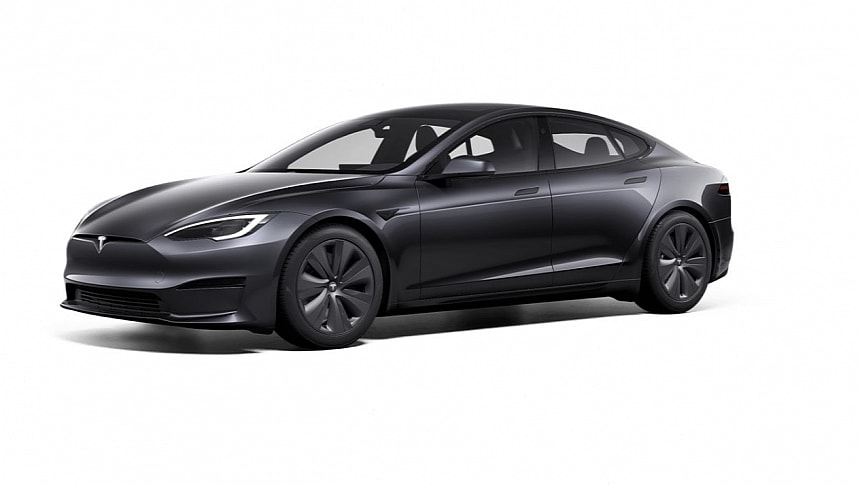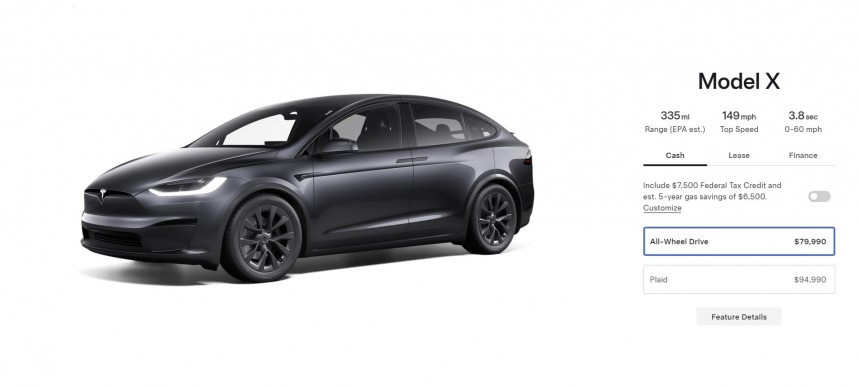The Model S came out in 2012, followed by the roomier Model X in 2015. It should come as no surprise that both are selling poorly, and it's hardly a surprise that Tesla is hiding these poor deliveries by not breaking down sales by model.
The second quarter 2024 sales report indicates 21,551 deliveries for "other models," which is Tesla's way of saying Model S, Model X, and Cybertruck. By comparison, the Model 3 and Y moved a grand total of 422,405 units globally.
Glancing over the 2023 numbers will not please Tesla enthusiasts, for the Model 3 and Y racked up 1.7 million deliveries compared to 68,874 for the Model S, Model X, and Cybertruck. Adding insult to injury, the automaker most people associate with Elon Musk has raised prices by $2,000 for both the S and X across the board.
Excluding the estimated gas savings over a period of five years, the 2024 Tesla Model S now starts at $74,990 for the dual-motor version. Stepping up to the manically quick Plaid means $89,990 from the outset, which is getting close to the recommended price of the luxury-oriented EQS 450+ from legacy automaker Mercedes-Benz.
The S-Class of electric vehicles doesn't benefit from the $7,500 federal tax credit for buying a locally-produced electric vehicle because eligible cars have to sticker below $55,000. We also have to remember that the Merc doesn't hold a candle to the Model S in terms of acceleration and driving range, with the Model S topping 1.99 seconds to 60 miles per hour (97 kilometers per hour) and 402 miles (647 kilometers) versus bests of 3.4 seconds and 352 miles (566 kilometers).
Obviously enough, the Model X has the upper hand over the EQS SUV. Its advertised prices are $5,000 higher than those of the S, with range and straight-line performance taking a hit from the increased weight. Even so, up to 335 miles (539 kilometers) and as little as 2.5 seconds to 60 are hugely impressive numbers for a heavy SUV.
5,148 pounds (2,335 kilograms) for the dual-motor version is still lighter than BMW's plug-in M5 and the 2025 Porsche Panamera Turbo S E-Hybrid. The plug-in sedans weigh a hefty 5,390 pounds (2,445 kilograms) and 5,311 pounds (2,409 kilograms), respectively, in US spec.
Turning our attention back to the Model X, the Austin-based automaker has kept the starting price of the Model X All-Wheel Drive below the $80,000 limit for prospective customers to access the aforementioned $7,500 federal tax credit. Tesla further made an interesting change to the $8,000 Full Self Driving package, which now adds the seven-seat option at no additional cost. Why is that? Of course, because of the tax credit.
While price increases usually indicate greater demand over the available supply, bear in mind that Tesla doesn't really care about delivery numbers for the aging S and X. The Model 3 and Model Y is where the money's at, with Tesla being laser-focused on keeping those two as relevant as possible in their segments.
Glancing over the 2023 numbers will not please Tesla enthusiasts, for the Model 3 and Y racked up 1.7 million deliveries compared to 68,874 for the Model S, Model X, and Cybertruck. Adding insult to injury, the automaker most people associate with Elon Musk has raised prices by $2,000 for both the S and X across the board.
Excluding the estimated gas savings over a period of five years, the 2024 Tesla Model S now starts at $74,990 for the dual-motor version. Stepping up to the manically quick Plaid means $89,990 from the outset, which is getting close to the recommended price of the luxury-oriented EQS 450+ from legacy automaker Mercedes-Benz.
The S-Class of electric vehicles doesn't benefit from the $7,500 federal tax credit for buying a locally-produced electric vehicle because eligible cars have to sticker below $55,000. We also have to remember that the Merc doesn't hold a candle to the Model S in terms of acceleration and driving range, with the Model S topping 1.99 seconds to 60 miles per hour (97 kilometers per hour) and 402 miles (647 kilometers) versus bests of 3.4 seconds and 352 miles (566 kilometers).
5,148 pounds (2,335 kilograms) for the dual-motor version is still lighter than BMW's plug-in M5 and the 2025 Porsche Panamera Turbo S E-Hybrid. The plug-in sedans weigh a hefty 5,390 pounds (2,445 kilograms) and 5,311 pounds (2,409 kilograms), respectively, in US spec.
Turning our attention back to the Model X, the Austin-based automaker has kept the starting price of the Model X All-Wheel Drive below the $80,000 limit for prospective customers to access the aforementioned $7,500 federal tax credit. Tesla further made an interesting change to the $8,000 Full Self Driving package, which now adds the seven-seat option at no additional cost. Why is that? Of course, because of the tax credit.
While price increases usually indicate greater demand over the available supply, bear in mind that Tesla doesn't really care about delivery numbers for the aging S and X. The Model 3 and Model Y is where the money's at, with Tesla being laser-focused on keeping those two as relevant as possible in their segments.

















